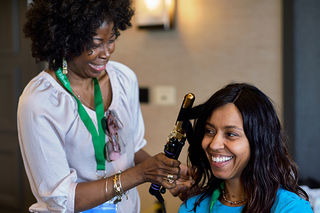
Body-Focused Repetitive Behaviors
Why Visiting a Hair Salon Is Tough for People With Trich
How I learned to manage my bi-racial hair despite my hair pulling disorder.
Posted September 19, 2018
GUEST POST
by Jennifer Mbanu

When I was little, my mother used to brush and braid my hair. I remember sitting on the floor between her knees for what seemed like an eternity as she negotiated with the long, thick, dark mane that cascaded down my back. I remember being self-conscious of that hair as a bi-racial child growing up in an almost all-white community. It was too thick, too unruly. I remember wishing my hair was silky and smooth and did what it was told. I hated having to always wear braids or a ponytail at my mother’s insistence.
The first trip to a hair salon that I can remember was the summer after my 4th grade year. I was off to church camp for a week in Wisconsin—the first week I would have without my mother to keep my hair under control. I remember loving the feeling of getting my hair washed, the warm water running down the sides of my face, the stylist's fingers massaging my scalp. It felt like such a luxury coming from a family that didn't spend a lot of time in beauty salons. I came out with a cute, shoulder-length cut that was easier for me to manage on my own, and I don't recall thinking about my hair at all during that fun-filled week.
By 7th grade, I began pulling my hair out, due to what I would later learn is a condition called trichotillomania. My hair was so thick and long that I was able to hide the habit from almost everyone except my mom. She began finding balls of long hair on the floor that would then jam up her vacuum. I remember her confronting me once with a ball of hair, and her questions were ones I couldn’t answer: "What is this? Why are you doing this?"
From middle school through college, I came up with creative ways to hide my hair loss. Pulling the sides up with the rest down, or placing a ponytail to hide the thin and bald spots on the crown of my head. Headbands to hide loss along the hairline, and hats when no creative hairstyle in the world could hide any longer the damage I had done.
The reactions I got from hair stylists were mixed. I recall one stylist spending a little time looking at my thin spots before recommending a product for hair breakage. The others paused over the spots, but pretended not to notice, and I was relieved. The year after my junior year in college, I decided to get braids in an effort to curb my pulling. I knew that a hair stylist would notice my thin spots, so I had a whole story lined up about how I was being treated with radiation. I didn't know that it was chemotherapy, not radiation that caused hair loss (the stylist did), or that it would have been much easier to have made up having alopecia or some other valid, involuntary hair loss condition. But I was still early in my trich journey, and it still seemed unthinkable to admit to anyone, even a cosmetologist, that my own hands had done what they were seeing.
If I had to name the most humiliating experience I had at a salon, it was going in with severe pulling, but enough hair that I was sure a professional could come up with a style. I gathered all of the courage I could muster, requested a private appointment, and told the black stylist that I had trichotillomania and needed some help with my hair. She was so kind and made me feel comfortable. Then she started asking questions, and finally asked if I had talked to my doctor. It was my answer that made her stop what she was doing. "You're doing this to YOURSELF?!?" And then she gave me a motivational speech and asked to pray with me. She was lucky she did a fabulous job with my hair because what I really wanted to do was either punch her in the face or run out in tears.
As a started my career, I switched to buying wigs – first bad ones at the local beauty supply store, then more expensive wigs as my budget allowed. By the time I was about to get married, at 26, I began researching hair replacement companies because I wanted to wear my hair down and not be self-conscious. The staff was friendly, they respected my privacy....and then they gave me the price: $1,000 (give or take) for a custom-made system. I wasn't even paying that much for housing at the time. I burst into tears the minute I got in the car. I was never going to be able to go swimming and go underwater. I would never get on a boat without worrying that the wind would rip my hair off my head. I would continue to have to be guarded when people hug me, or when kids are playing around me. I would never be intimate with my husband without wearing a bandana or being more focused on making sure my wig didn't come off than I was on him. I was devastated.
But years passed, and I survived, and "never" came quicker than expected. As my career advanced and my salary increased, I finally found hair solutions that work for me. More importantly, I have found cosmetologists who are understanding, respectful of my privacy, and are in a position to be a champion for awareness of body-focused repetitive behaviors (BFRBs) like trich.

Cosmetologists can play a huge role in ending isolation and providing real solutions for individuals living with hair pulling or skin picking disorders. The TLC Foundation for Body-Focused Repetitive Behaviors maintains a nationwide directory of hair and skin care providers who are knowledgeable about BFRBs. By being part of a referral system, and training in hair loss solutions, they can become a partner and safe place for trichsters to fall in order to have the luxurious, relaxing salon experience I first had as a child.
Jennifer Mbanu is a healthcare consultant and personal health coach living in the Indianapolis area with her husband and two children.



